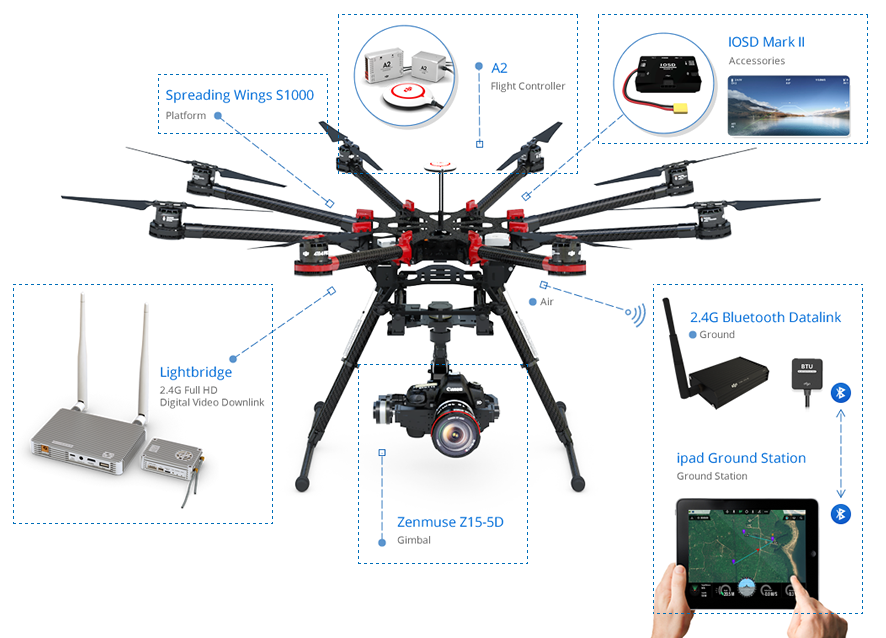This article is more than 1 year old
A drone of one's own: Reg buyers' guide for UAV fanciers
Hardware: Check. Software: Huh? Licence: Licence...?
Options to suit any application, or bank balance

The DJI drone flying platform
GoPro dominates the camera business, although other options are available and bear in mind that lenses are heavy things: adding an additional lens can reduce flying time markedly, and might affect the gimbal options. The gimbal holds the camera in place, and sometimes allows it to be aimed remotely. Horizontal control is rare (one just turns the whole drone), but vertical panning is essential for controlling the shots.
Batteries are usually lithium polymer, as they offer the best power-to-weight ratio (short of a petrol engine). The problem with Li-on is their tendency to burst in to flame especially when being charged, so ensure your batteries fit inside a metal tin to be on the safe side. And you'll want spare batteries too — even the best drone will only fly for 20 minutes or so and you don't want to spend hours recharging so you can re-shoot that spontaneous cycling stunt.
Lots of drones come with a pair of radios, one for sending control data and another for feeding back live video to the pilot, and if you're working from a flying platform you'll need both. The live video generally comes over a Wi-Fi link, which limits range to a few hundred meters and is easily blocked by water-sodden trees. Control signals are sent over a different band so propagate better, though some drones are saving weight by dropping the second radio and doing everything over Wi-Fi.
If both signals disappear then the drone will panic, but a clever drone will be able to make its way home or, at least come down gracefully.
How clever the drone is will depend on the Flight Control computer, and the GPS that it is connected. Better flight control means more stable flight, and more features such as waypoints and directorial presets, but don't get distracted by the fripperies — stability is the most important thing of all.
An assembled drone is a fragile thing and most drones will dismantle for shipping, but unless you like to arrive everywhere early you might want to consider how long it takes to assemble — and how you're going to transport it. Carrying cases are surprisingly rare, but an essential addition unless you live very close to those you're hoping to impress.
Got a licence for that drone, sir?
You don't need a licence to own or fly a drone, but if you're going anywhere near buildings or people, or if you're planning to charge anyone for the pictures you're taking, then you'll need a Civil Aviation Authority (CAA) Permission for Aerial Work. For that you'll need to complete an approved training course, as your civilian pilots' licence counts for nothing and you'll need to get some insurance, too.
To avoid a licence you'll need to stay at least 150 metres from, and avoid flying over, any "congested area" or gatherings of more than 1,000 people. You'll also have to avoid flying over any people, or vehicles, and keep you drone at least 50 metres away from both those things at all times (with the exception of yourself, and people under your control).
Even an abandoned moorland setting can trip you up if the footage goes commercial. Commercial use also requires a CAA licence, and that would include photographs uploaded to Demotix, or artsy shots sold in frames, or even your share from the YouTube Partner Program when your upload goes viral.
Either way, you're going to need to attend one of the two training schools that are recognised by the CAA — EuroUSC in Rickmansworth and Resource Group in Liverpool — so if you don't live there you'll need to add a hotel bill to the £1,200 or so the training will set you back. Then there's the annual licence, £113, and the fact both companies require you to have liability insurance of about £800, making the drone a minor part of your expenses.
You'll need to sell a lot of artsy prints to make your money back.
General advice
Lastly, after talking to drone owners, I came up with a useful checklist for anyone considering their own flying machine – things our buyers wished they had thought of before taking the plunge, and things you might like to consider. Before you go out and get your drone, consider the following:
- Don't buy a drone for your kids: Any drone cheap enough to be a toy will lack the flight control needed to make to make it fun. Most children won't have the patience to learn, leading to frustration on all sides.
- Don't rush into getting a licence: The CAA is planning to change the licensing requirements soon, so don't blow two grand getting certification unless your business depends on it. For amateurs taking an aerial shot of a mate's wedding it's best just to say nothing and take your fee in beer.
- Buy a carrying case: If you're going to show off your drone you'll need to take it with you.
- Update your software often: All the bigger drones come with replaceable software, and all the manufacturers are constantly tweaking their code to improve the performance.
- Fit new landing gear: Bounce when you land, using pipe lagging or sprung cable ties, to ensure bumpy landings aren't turned into critical crashes.
- And though it's been said before elsewhere — read the f*cking manual: Failing to properly synchronise the navigation software, or connect the GPS, can result in your drone setting off into the sunset to seek out a new life, without you. ®
